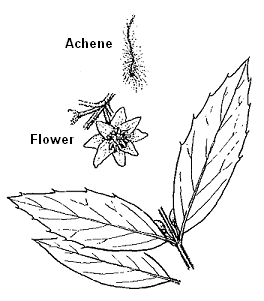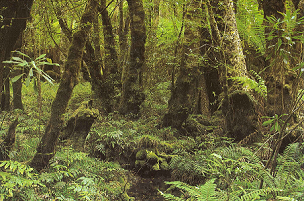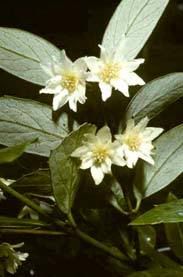Southern Sassafras
| Southern Sassafras | ||||||||||||||||||||
|---|---|---|---|---|---|---|---|---|---|---|---|---|---|---|---|---|---|---|---|---|
| ||||||||||||||||||||

|
Under Construction
The conical shaped Southern Sassafras looks like it comes straight out of Enid Blyton's Toy Town. The tree is much loved by Errinundrians with the leaves appearing on the national flag. The bark, leaves and flowers give off a strong nutmeg scent. The traditional drink of Errinundera is a cup of tea infused with a sassafras leaf to give it extra flavour.

Sassafras lined gully at Kanooka Creek. Note the emergent Shining Gum on the surrounding ridge.
Readily recognisable by its conical habit and yellow-green foliage, it is a small to medium sized tree usually 10-15 m in height but occasionally reaching 25 m with a diameter of 0.75 m. Young trees are usually of good form with straight trunks, horizontal branches and conic crowns of dark green, shining leaves. Older trees have open crowns with the lower branches drooping to ground level. Root layering often produces groups of stems.
Southern Sassafras is widely distribruted on cool moist sites. The climatic zone is cool sub-humid to cool humid, with mild to warm moist summers. The mean maximum temperature of the hottest month is 15ºC to 20ºC and the mean minumum of the coldest month is -2ºC to +5ºC. Up to 50 frosts a year occur and snow falls each year at higher altitudes.

A creek winds through sassafras near First Creek Falls.
It is found in gullies, along creek lines and up the sides of valleys. Soils are commonly xanthozems, or brown and yellow podsolics, often fairly deep clay loams with a thin organic horizon, derived from intermediate igneous rocks such as granodiortie or dacite, or Silurian or older sediments.
Atherosperma moschatum ("Bearded seed"; "musk-scented") is usually a subsidiary species in cool temperate rainforests (nanophyll moss forests) but occasionally it is found in more or less pure stands such as along creek lines, where it may be associated with manfern (Dicksonia antarctica). In Errinundera it is also found with blackwood (Acacia melanoxylon), pittosporum (Pittosporum bicolor) and austral mulberry (Hedycarya augustifolia). On the Errinundera Plateau it occurs beneath an overstorey of shining gum and is associated with mountain quandong (Elaeocarpus holopetalus), tree waratah (Telopea oreades), mountain pepper (Tasmannia lanceolata) and mountain plum-pine (Podocarpus lawrencei).

The flowers have eight white perianth segments in two whorls. Note the pale underneath of the leaves (top) with lime green upper surface (bottom).
The wood is highly prized in furniture making and turnery. The sapwood is pale; the heartwood also pale but sometimes pale grey, to light brown and sometimes black. "Blackheart sassafras" is highly sought after for specialty work. The wood-working industry of Puggaree is particularly renowned for its sassafras furniture and house fittings.

Sassafras wood shades, from pale grey and brown to "blackheart".
Atherosperma moschatum was first described by the French botanist J J H de Labillardière. He initially studied both medicine and botany, but is most famous for his work as an explorer and botanist. In 1791 he accompanied the French expedition under Bruny D'Entrecasteaux in the ships "La Recherche" and "L'Esperance" in search of La Perouse. While in the Australian area, he made botanical collections in southwestern Australia and Tasmania. Because of a state of war between the Dutch and French during this period, members of the expedition were held in Java by the Dutch and the collections confiscated and sent to England. Through the diplomacy of Joseph Banks, these specimens were eventually returned to Labillardière.
The tree is not related to the laurels (Sassafras spp.) of North America.
Inspirations
- Boland, Brooker, Chippendale, Hall, Hyland, Johnston, Kleinig & Turner - Forest Trees of Australia
- Costermans - Trees of Victoria and Adjoining Areas
- Costermans - Native Trees of South-Eastern Australia
- Edited Groves - Australian Vegetation
- Native Forests Action Council - The Forests of East Gippsland
